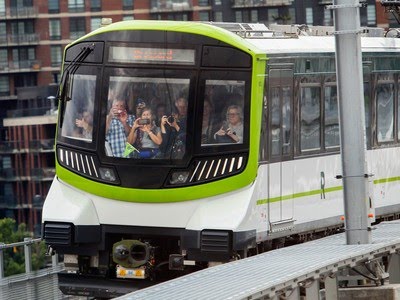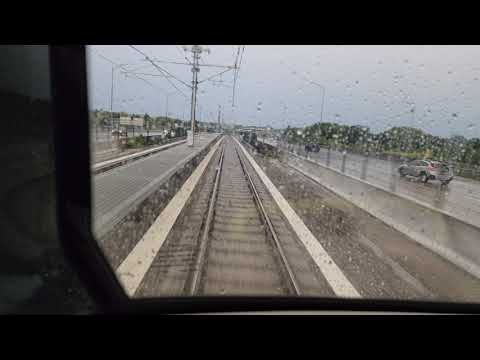En tant que résident du centre ville de Montreal, je vais lui répondre: Je veux plus de de ton bus.
Je veux plus de ton bus diesel qui traverse le centre ville en toutes vitesses. Je veux plus de ton bus qui reste bloquée sur robert bourassa et qui accentue le trafic au centre ville.
Moi je comprend de son commentaire que le transfert et l’intégration entre les différentes étapes de transport est mal planifié et meilleurs dans d’autres villes.
Entouka c’est l’expérience que je vis depuis 3 semaines, mais je ne peux pas comparer à d’autres villes, n’ayant pas eu ces expériences ailleurs.
La bulle du REM va bien, mais se rendre à cette bulle, c’est pas si plaisant et bien évidement plus long qu’un bus direct. L’expérience globale demande à être améliorer.
Je demande pas à ce qu’on reviennent en arrière, mais si tout le monde pourrait se parler et faciliter les transferts, les entrées et les sortis, la vie serait plus belle ! ![]()
Maintenant, ce lundi le 21, on va voir comment le RTL va améliorer une partie de l’expérience globale.
Fred Duke strikes again ![]()
![]()
Josh Freed: Sweet infrastructure dreams are inspired by the REM’s success
Canadian and even U.S. urban planners are abuzz about it, and urban experts everywhere are hoping Montreal’s light rail system can break the logjam that has many cities afraid of major projects.
Josh Freed • Special to Montreal Gazette • Published Aug 19, 2023

People look out the window of a REM train in the Griffintown area of Montreal as it heads toward the South Shore on Saturday, July 29, 2023. PHOTO BY JOHN KENNEY /Montreal Gazette
Could our new REM light rail system be a turning point in Montreal and perhaps even Canadian history?
Tens of thousands of massively enthusiastic riders turned out in its first weeks. That was typical of summer in this city, where anything’s an excuse for a jam-packed party — even the Festival of Riding a New Train.
But beneath the initial excitement is something bigger: our long battered city may finally be capable of dreaming again, after decades of slumber — while other cities dream with us.
In recent weeks, I’ve heard repeatedly that Canadian and even U.S. urban planners are abuzz about our new REM, as no one has done almost anything as ambitious in transport for decades.
Let alone in just five years.
As one world-famous B.C. urbanist tweeted: “Another BIG city-building win for #Montreal … 68 km. and 26 stations (to come) … Seen as huge success to replace cars.”
The REM has gotten urban experts everywhere hoping this project can break the logjam that has many cities afraid of major infrastructure dreams — for good reason.
Last time Montreal was a dreamer’s town I was a teenager during Expo 67, when we grew up believing big urban dreams weren’t just possible — they were boringly normal.
In less than a decade, we built Place Ville Marie, a world-stunning métro and a new seaway — then held a much celebrated world’s fair.
By the late ’60s, we were practically blasé about dreams — too blasé. Thus came Chapter 2, the 1976 Olympics when dreams turned to nightmares.
There was the billion-dollar stadium that still poses the same painful choice today: To be, or to be blown up, that is the question? There were the Velodrome and Olympic Village white elephants and Mirabel adding to the herd.
To boot, we bulldozed entire neighbourhoods with no public input, blinded by overambition and glory. When the smoke from burning dollar bills cleared, it left most Quebecers feeling we couldn’t do any large project well.
We turned into a city of cynics who measured every project with a standard formula: take the announced budget and schedule, multiply by 2.5 — then expect worse.
For Montrealers, the word “mega” before “project” didn’t mean big, it meant disaster.
We carried on carefully. We wisely built a modest but graceful symphony hall because we were terrified to think bigger. We chickened out of a plan to blaze a trail by heating Ste-Catherine Street’s sidewalks.
But in fairness, other North American cities struggled with megaprojects, too. The Big Dig in Boston went massively over budget and took 15 years.
Ottawa’s light rail line is a costly debacle since opening, while Toronto’s much-tinier-than-our-REM new line is still under construction after 13 years.
So pessimism about ”big projects gone bad” has infected Canada and the U.S. and nitpicked most big infrastructure dreams to a standstill.
The first glimpse Montrealers had that things could change was the new Champlain Bridge. When they first announced the bridge, I thought it was another fantasy that would be delayed forever — or for never.
Like the endlessly talked-about imaginary fast train to New York.
But as the Champlain behemoth rose wondrously over the St. Lawrence River, it went up as efficiently as a giant Lego set — and many of us felt stirrings of forgotten pride.
Even so, I remained skeptical about the REM, expecting it to come in 10 years late at 10 times the estimated price. Instead, it’s pretty close to being on budget and schedule — especially impressive through a pandemic.
The driverless train is sleek, fast, ecologic and futuristic, filled with excited passengers with faces pressed to the windows.
There are small glitches and larger noise problems to solve. But if the REM works well and quickly adds its airport link, it could ignite more dreams, here and across Canada.
Big infrastructure projects are crucial to cities’ futures, though they’re rarely popular when built. Paris’s now celebrated Pompidou Centre art gallery and even the Eiffel Tower were hated in their day.
We sometimes need daring projects, but we need caution, too.
As one Toronto urban expert told me: “We can’t keep shying away from big, often green infrastructure projects, but we also need to be careful to get them right.”
If we think bigger (but not too big), what could Montreal build next: the Pink Line Mayor Valérie Plante made up on a napkin? The Cavendish extension Montreal’s west enders have been promised for decades?
Covering Décarie and Ville Marie Expressways? Or our biggest fantasy: to see our neverendum roadwork actually endum?
What if Canada starts to think bigger, too, stirred by the REM’s success? Could we build that Montreal-Toronto fast train it feels like we’ve talked about since Confederation.
A Calgary-Edmonton one? Or greening our ancient, inefficient national power grid?
In the movie Field of Dreams, they say: “Build it and they will come.” Let’s hope the REM proves as big a success with passengers as it is with urban planners, and sparks a new age of excitement, enthusiasm and well … cautious optimism.
Can the REM be our Field of Dreams?
The thing that bothers me about that article is something that feels like it should be obvious… The cities that have kept building transit in the last few decades have been tackling small chunks at a steady pace. Huge projects get complicated fast which is part of why costs explode.
The other thing that bothers me is that the level of delusions in that article. Heated sidewalks… Sounds like a quick way to spend a lot of energy and money.
Many cities around the world have heated sidewalks, it’s really not that complicated, it’s just that Montreal somehow failed at it and never tried again which is a shame
On this Europe is so far ahead. I recall seeing high speed rail plans going out 20, 25 years saying, in 8 years this segment will be built, in 12 we add these stations, etc.
Obviously they face delays too but the quality of infrastructure is simply at another level, and it feels like a lot of it is about funding stability and long-term planning - instead of relying on politicians to give hand-me-downs ahead of elections, having a more technocratic state with long-term plans.
Question ici: Est-ce que vous croyez que la branche Ouest du REM ouvrira vraiment fin 2024? À la vue de l’avancement des travaux et de période de tests à faire + le fait que fin 2024 c’est le début de l’hiver. Plutôt printemps 2025?
Je dirais même automne 2025 (genre aout), au mieux, comme cette première phase.
J’espère qu’ils prévoient avoir plus de trains pour l’ouverture. 120k passagers va être comme des peanuts comparé à ce qu’il va y avoir. Je sens (gut feeling, rien de statistique) que Montréal au complet va vouloir le prendre.
Bon article. J’aime l’effervescence des articles sur les transports dernièrement. Anecdcotes, analyses, opinions, débats. C’est vraiment l’âge d’or des discussions sur les transports.
Considérant que la majorité des gros problèmes ont probablement été découvert lors de la marche à blanc sur la rive sud, je m’attends à une période de test moins longue dans l’Ouest de l’Île de Montréal. Avec cela de dit, si ils veulent vraiment réussir à ouvrir ces branches en 2024, ils va falloir qu’ils complètent la construction des voies avant l’hivers pour pouvoir commencer les test.
Il y aura cependant plus de variables: plus de stations, la convergence-divergence des trains dans les divers branches, etc.
Et on ne parle même pas du dossier du bruit sur tout ce tracé.
Je sens surtout que CDPQi ne veut pas revivre le lundi de l’ouverture à plus grande échelle.
It’s not an “article,” Josh Freed writes free-form opinion pieces, often not based in reality.
Si la CDPQ-Infra ont un bon processus d’amélioration continue en place, les quelques problèmes de l’ouverture de la rive-sud doivent être déjà évités pour la branche Ouest.
I’m rather certain that the switch is just beyond where the camera was looking when the video started.
I wonder what time that was. I ran into a train that was unable to depart Central Station yesterday evening.
Also, the announcement said that there was service disruption between Rive-Sud and Gare Centrale stations! Whaaaat… I thought that was updated ![]()
Seems like it basically needed to be rebooted (or similar). Interesting.
Pourquoi est-ce que cela a forcé l’arrêt du train dans l’autre direction? Mesure de précaution en cas d’évacuation?
“historical moment” ![]()
Avec l’avancée de la technologie de voix de synthèse, j’aurais pu m’attendre un timbre beaucoup plus humain comme Siri ou l’assistance Google.
Malgré tout, on est quand même loin de la voix ultra robotique et déprimante de la TTC.
